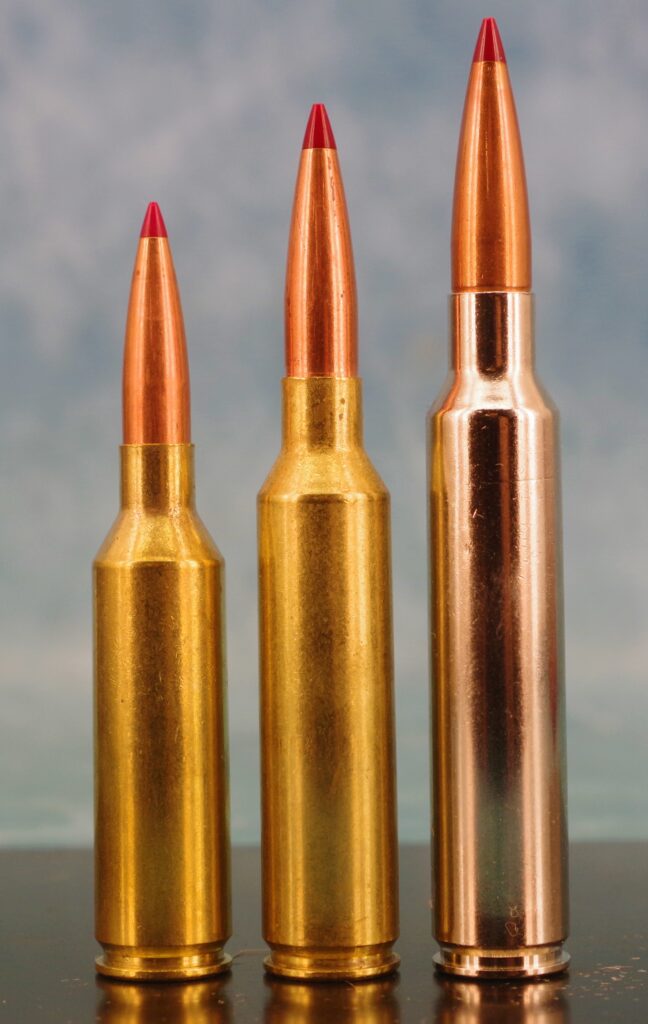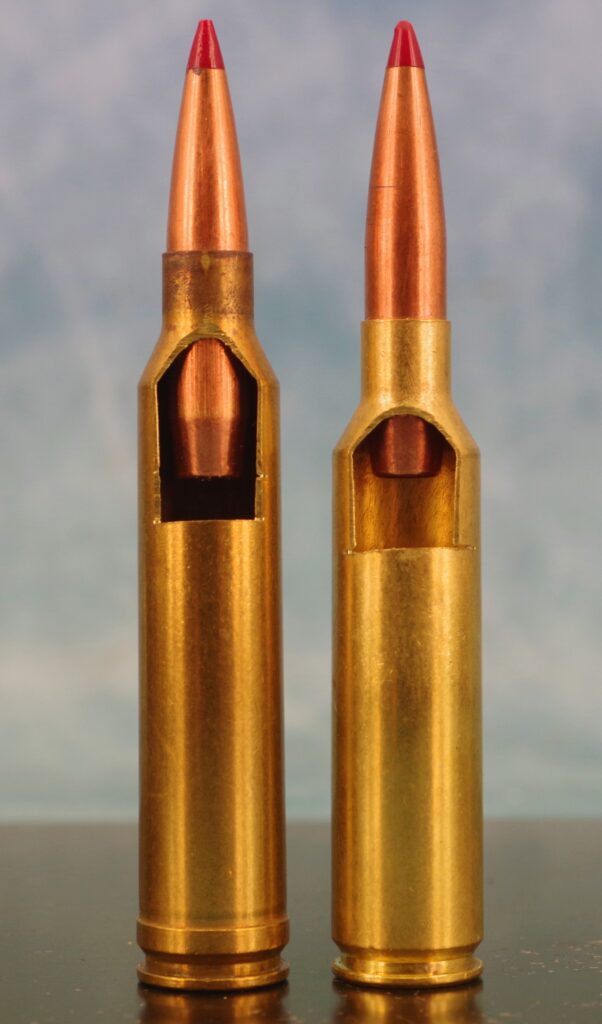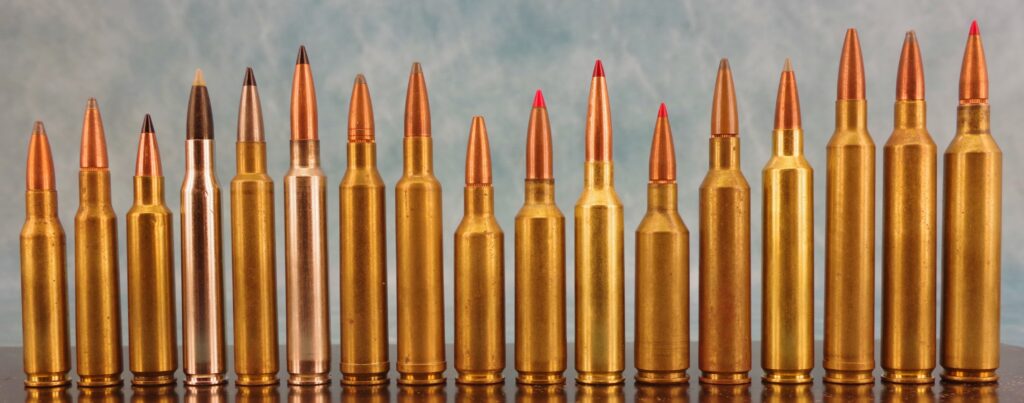Guns and Ammo, The Amazing 7mm
America’s New Favorite Hunting Cartridge
By Jon R. Sundra
Originally published the November-December issue of Safari Magazine.
The introduction this year of Hornady’s 7mm PRC has in my memory generated more excitement than any big game cartridge since the debut of the .264 Win. Magnum in 1959.

Yeah, I was there, already a rifle weenie at the age of 19. Anyway, as I see it, the 7 PRC is at the forefront of a trend that will soon see the ascendency of the .284 — also known as the 7mm’s — over the .30 calibers as our most popular hunting caliber.
How we got to this point is an interesting one because the 7mm road has been long and bumpy.
For me, it started nearly 60 years ago. It was 1965, and I had just escaped college with a BA in English literature. The only centerfire rifle I owned was a Remington 722 that I had re-barreled to .22-250 (which was still a wildcat at the time). I did so because the only hunting I was able to do (and afford), was potting woodchucks locally. As for what cartridge I’d choose to start my real hunting career, that’s something I agonized over. It was the iconoclast in me that the most popular calibers of the day — the .270 Win. and .30-06 — held no fascination for me. I was predisposed for something else. The 7mm had a metric designation that made it that much more exotic and that much more appealing.
The 7mm Rem. Magnum had debuted three years earlier, and after doting on ballistic charts and reading articles on its performance afield, it seemed to me the perfect cartridge. Never mind the fact that I never fired so much as a shot from a rifle so chambered. But that’s not unusual. Lots of us decided to commit to a specific cartridge and rifle for all kinds of reasons other than empirical ones.
Prior to the unveiling of Remington’s Big Seven in 1962, the most widely known cartridge was the 7×57 (or 7mm Mauser) of 1892. Ultimately, 14 countries in Europe and South America adopted it as their service cartridge. In the period between the world wars, Remington and Winchester chambered for it sporadically, but like I said, being a metric caliber, it was thought to be…well, foreign.
The first real effort to establish the 7mm on these shores came in 1957 when Remington rolled out its .280 Rem. Many years ago, at a Remington writers’ seminar, I had a conversation with Wayne Leek and Mike Walker, the two guys who designed the cartridge. The initial plan was to chamber Remington’s Model 740 semi-auto, and the pump action 760, for the .270 Win., but they ran into problems. The .270 was designed for Winchester’s Model 54 bolt action rifle, and as such, was factory-loaded to an Maximum Average Breech Pressure (MABP) of 65,000 psi, which even today is about as high as factory ammo gets. Long story short, the Model 740 would have to handle all brands of .270 factory ammunition, and it proved to be just too punishing to the 740’s gas-operated semi-auto action. The .280 Remington, then, was a result of Plan B. By increasing the .277-inch bullet diameter of the .270 Win. a mere .007-inch to .284, and lowering the MABP to 60,000 psi, the 740 worked just fine. However, the combination of the lower operating pressure and the 740’s 22-inch barrel made Remington’s claim of “.270 performance” wishful thinking. And the gun writers of the day were only too happy to point that out. As a result, the .280 was given a cool reception.

Based on the spectacular success of their 7 Mag, in 1978 Remington decided they could breathe new life into the moribund .280 by introducing a new 150-grain load and renaming it 7mm-06. The moment it was announced at the annual writers’ seminar, I was the first to raise my hand.
“I think you’re asking for trouble,” I said. “Calling it the 7mm-06 intimates that it’s the result of simply necking-down a .30-06 case, and it’s not.”
The .280’s datum line (headspace dimension, hence body length) is .052 inch longer than that of the ’06. If some handloader were to assemble a load based on a necked-down ’06 case, and fire it in a .280 chamber, that extra .052 inch of headspace would likely cause a case-head separation and gas blowback. That ain’t good!
Fortunately, Remington had only a limited run of ammo with the 7mm-06 headstamp, and maybe 20 or so Model 700s so-stamped for us guys to test. Very quickly Remington changed the name to 7mm Express Remington. But ultimately that proved to be another mistake. Too many people were now confusing it with the 7mm Rem. Magnum. In 1981, Remington decided to revert to the original .280 Rem. designation.
In 1963 Winchester made a mistake very much like Remington’s in that they claimed .270 Win. performance for their brand new .284 Win. The .284 was unique in that it was totally new and not based on any existing case; it had a rather squat, beltless body and a 35-degree shoulder, which yielded a powder capacity very close to that of the .270 and .30-06s. However, because it was designed specifically to fit Winchester’s short-action Model 88 lever action and Model 100 semi-auto, maximum overall cartridge length was limited to 2.8 inches, so the 150-grain bullet had to be deeply seated. And because the 100 was a semi-auto, SAAMI specs were set at a surprisingly low 56,000 psi, or 10,000 below .270 pressure levels. So much for “.270 performance.”
While the .280 Rem. and .284 Win. were not well received, the 7mm Rem. Magnum achieved stardom virtually overnight. As to why, it may have been simply a matter of being in the right place at the right time. Its metric designation suddenly didn’t seem to matter. In the 59 years between the introduction of the 7mm Rem. Magnum in 1962, and the 7mm PRC this year, a lot has happened in the .28 caliber — .280 Rem. and .284 Win. — sagas notwithstanding. In fact, more new 7mm cartridges — commercial, proprietary and wildcat — have been introduced than any other hunting caliber. Many years ago, I recall reading the results of a test conducted at the turn of the last century by the U.S. Army just prior to its adoption of the .30-06 as our martial cartridge. The conclusion was that in the 8 1/2-pound 1903 Springfield rifle, the recoil approached the tolerance limits of the average soldier. We’re talking about 25 foot-pounds of recoil. Beyond that, the ability Just off the top of my head I can name 15. As to why, there’s always the question of whether it’s in response to consumer demand, or the gun and ammo makers creating the demand by introducing new stuff. It’s probably some of both. But I think the most compelling reasons have to do with more ballistically savvy buyers and recoil considerations. In the past, a hunter might have chosen a .308 Win., 30-06 or a .300 Win. Magnum. Now they are going to a 7mm equivalent: 7mm-08, .280 Rem. or a 7mm Rem. Magnum.
Many years ago, I recall reading the results of a test conducted at the turn of the last century by the U.S. Army just prior to its adoption of the .30-06 as our martial cartridge. The conclusion was that in the 8 1/2-pound 1903 Springfield rifle, the recoil approached the tolerance limits of the average soldier. We’re talking about 25 foot-pounds of recoil. Beyond that, the ability to shoot accurately begins to diminish. That hasn’t changed, not for the hunter, not for the soldier, and especially not for the competitive shooter.
I hasten to add that with practice and a little determination, any man or woman can learn to live with recoil to where the accuracy potential approaches optimal. That applies to the soldier and the competitive shooter. But I’m talking Joe Average Deer Hunter, for he’s the guy who drives the market, the guy who doesn’t run a box of shells through his rifle in a year. To him, recoil is more of a factor, and, as stated previously, the average hunter has really become more knowledgeable about ballistics.
Which brings us to the 7mm PRC, and how it compares to its big brother, the .300 PRC. Both are Hornady developments, and both embody all the characteristics that define the newest generation of rifle cartridges: shorter, fatter cases of minimum body taper, no belt and shallower seated bullets to maximize usable powder space. Shorter powder columns produce more uniform velocities, hence accuracy. Sharper, 30-degree shoulders provide more positive headspacing, and changes in the chamber throat minimize bullet yaw enroute to it engaging the rifling. But what most characterizes the “modern cartridge” is that it launches heavier, longer and more aerodynamic bullets requiring faster barrel twist rates to stabilize. I believe the following comparison is a fair one for which I used Hornady’s own Ballistic Calculator and their own factory-load velocities. I, however, used 250 yards as my zero range rather than the 200-yard standard.

The only way to compare apples to apples is to use bullets of the same weight relative to their diameter, that is, their sectional density (SD). The 175-grain bullet is to the .284 caliber what a 200-grain bullet is to the .308, the former having an SD of .310, while the latter has an SD of .301; both are Hornady’s ELD-X hunting bullets.
You have to admit, the differences between the two are insignificant, but for the .30 to match the 7mm in velocity and trajectory requires a larger cartridge case, some 10 percent more powder, and a significant 23% percent more recoil! That figure is an average derived using three recoil-computing programs. In an 8 1/2-pound rifle, the 7 PRC recoils to the tune of 28.5 foot-pounds, while the 300 PRC punches back with 37.2 foot-pounds, which is exactly the same recoil generated by a .375 H&H Magnum pushing a 300-grain bullet at 2,500 fps in a 9.5 lb. rifle!
BOTTOM LINE
Is it worth 23% more recoil to deliver 6% more energy at 500 yards over virtually the same trajectory? That’s the question the 7 PRC poses, as do all the other 7mm’s when compared to their .30 caliber equivalents, and more and more hunters are saying no. .
Jon R. Sundra, is Safari Magazine’s Field Editor, and has been a professional firearms writer for more than 50 years.

